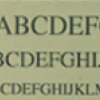Free Online Productivity Tools
i2Speak
i2Symbol
i2OCR
iTex2Img
iWeb2Print
iWeb2Shot
i2Type
iPdf2Split
iPdf2Merge
i2Bopomofo
i2Arabic
i2Style
i2Image
i2PDF
iLatex2Rtf
Sci2ools
CVPR
2001
IEEE
2001
IEEE
Optimal Texture Map Reconstruction from Multiple Views
The recovery of 3D models from multiple reference images involves not only the extraction of 3D shape, but also of texture. Assuming that all surfaces are Lambertian, the resulting final texture is typically computed as a linear combinationofreferencetextures. This is, however, nottheoptimal means for reconstructing textures, since this does not model the anisotropy in the texture projection. Furthermore, the spatial image sampling may be quite variable within a foreshortened surface. This also has important implications for computer vision techniques that involve analysis by synthesis and the image-based rendering (IBR) technique of viewdependent texture mapping (VDTM). In this paper, starting with sampling theory, we show how weights should be spatially distributed for optimal texture construction. The local weights take into consideration the effects of anisotropy and variable spatial image sampling. We also present experimental results to verify our analysis.
Computer Vision | CVPR 2001 | Final Texture | Optimal Texture Construction | Texture Projection | Variable Spatial Image | Viewdependent Texture |
| Added | 12 Oct 2009 |
| Updated | 29 Oct 2009 |
| Type | Conference |
| Year | 2001 |
| Where | CVPR |
| Authors | Lifeng Wang, Sing Bing Kang, Richard Szeliski, Heung-Yeung Shum |
Comments (0)

